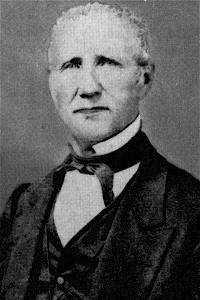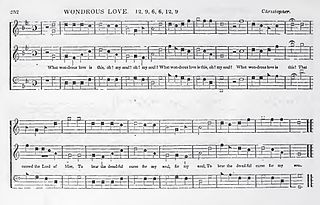Related Research Articles

A hymn is a type of song, and partially synonymous with devotional song, specifically written for the purpose of adoration or prayer, and typically addressed to a deity or deities, or to a prominent figure or personification. The word hymn derives from Greek ὕμνος (hymnos), which means "a song of praise". A writer of hymns is known as a hymnist. The singing or composition of hymns is called hymnody. Collections of hymns are known as hymnals or hymn books. Hymns may or may not include instrumental accompaniment.

Shape notes are a musical notation designed to facilitate congregational and social singing. The notation, introduced in late 18th century England, became a popular teaching device in American singing schools. Shapes were added to the noteheads in written music to help singers find pitches within major and minor scales without the use of more complex information found in key signatures on the staff.

A hymnal or hymnary is a collection of hymns, usually in the form of a book, called a hymnbook. They are used in congregational singing. A hymnal may contain only hymn texts ; written melodies are extra, and more recently harmony parts have also been provided.

The term American folk music encompasses numerous music genres, variously known as traditional music, traditional folk music, contemporary folk music, vernacular music, or roots music. Many traditional songs have been sung within the same family or folk group for generations, and sometimes trace back to such origins as the British Isles, Mainland Europe, or Africa. Musician Mike Seeger once famously commented that the definition of American folk music is "...all the music that fits between the cracks."

Sacred Harp singing is a tradition of sacred choral music that originated in New England and was later perpetuated and carried on in the American South. The name is derived from The Sacred Harp, a ubiquitous and historically important tunebook printed in shape notes. The work was first published in 1844 and has reappeared in multiple editions ever since. Sacred Harp music represents one branch of an older tradition of American music that developed over the period 1770 to 1820 from roots in New England, with a significant, related development under the influence of "revival" services around the 1840s. This music was included in, and became profoundly associated with, books using the shape note style of notation popular in America in the 18th and early 19th centuries.

The Southern Harmony, and Musical Companion is a shape note hymn and tune book compiled by William Walker, first published in 1835. The book is notable for having originated or popularized several hymn tunes found in modern hymnals and shape note collections like The Sacred Harp.

William Walker was an American Baptist song leader, shape note "singing master", and compiler of four shape note tunebooks, most notable of which are the influential The Southern Harmony and The Christian Harmony, which has been in continuous use.
The fuguing tune is a variety of Anglo-American vernacular choral music. It first flourished in the mid-18th century and continues to be composed today.
The Christian Harmony is a shape note hymn and tune book compiled by William Walker. The book was released in 1866. It is part of the larger tradition of shape note singing.

Ananias Davisson was a singing school teacher, printer and compiler of shape note tunebooks. He is best known for his 1816 compilation Kentucky Harmony, which is the first Southern shape-note tunebook. According to musicologist George Pullen Jackson, Davisson's compilations are "pioneer repositories of a sort of song that the rural South really liked."
The Kentucky Harmony is a shape note tunebook, published in 1816 by Ananias Davisson. It is the first Southern shape-note tunebook.

Appalachian music is the music of the region of Appalachia in the Eastern United States. Traditional Appalachian music is derived from various influences, including the ballads, hymns and fiddle music of the British Isles, the African music and blues of early African Americans, and to a lesser extent the music of Continental Europe.
William Clarke Hauser was an American minister, medical doctor, teacher, composer, and music publisher.
James Churchwell Luttrell II was an American attorney and politician who served as Mayor of Knoxville, Tennessee, during the Civil War. His eight-year term (1859–1867) was the longest for any Knoxville mayor until the late 20th century, when it was surpassed by Victor Ashe's 16-year term. Luttrell also served as state comptroller in the late 1850s, and was elected to the state senate following his term as mayor.

"What Wondrous Love Is This" is a Christian folk hymn from the American South. Its text was first published in 1811, during the Second Great Awakening, and its melody derived from a popular English ballad. Today it is a widely known hymn included in hymnals of many Christian denominations.

"Glorious Things of Thee Are Spoken", also called "Zion, or the City of God", is an 18th-century English hymn written by John Newton, who also wrote the hymn "Amazing Grace". Shape note composer Alexander Johnson set it to his tune "Jefferson" in 1818, and as such it has remained in shape note collections such as the Sacred Harp ever since. However, the hymn is most often set to the tune of Joseph Haydn's "Gott erhalte Franz den Kaiser". In recent decades it has been sometimes replaced by "Abbot's Leigh". This was written for this text by Cyril Vincent Taylor in 1942 while he was a producer of Religious Broadcasting at the BBC and stationed at the village of Abbots Leigh. Multiple other tunes have also been used with the hymn.
Eliakim Doolittle was an American composer, schoolteacher, and singing teacher, the younger brother of Amos Doolittle, first cousin of composers Reuben Munson and Amos Munson, and uncle of senator James R. Doolittle. His most well-known composition was the hymn tune "Exhortation", a fuging tune that was first printed in The Musical Harmonist and later included in The Sacred Harp.

John Wyeth (1770–1858) was a printer in Harrisburg, Pennsylvania who is best-known for printing Wyeth's Repository of Sacred Music, Part Second, which marks an important transition in American music. Like the original Repository of 1810, Part Second used the four-shape system of Little and Smith in The Easy Instructor to appeal to a wider audience; but its pioneering inclusion American folk tunes influenced all subsequent folk hymn, camp meeting, and shape note collections. Musicologist Warren Steel sees Wyeth's Repository of Sacred Music, Part Second as marking "the end of the age of New England composer-compilers (1770-1810) and the beginning of the age of southern collector-compilers (1816-1860)."

The Shenandoah Harmony is a 2013 republication of the works of Ananias Davisson (1780–1857) and other composers of his era, in the format used by modern shape note singing groups. Although a number of new shape note tune books were compiled and published in the two decades leading up to the publication of the Shenandoah Harmony, this volume is notable as "the largest new four-shape tunebook published for more than 150 years." The book is named after Shenandoah Valley, whose importance in the emergence of a distinctive Southern shape-note singing tradition has been noted by many musicologists. Authentic South reporter Kelley Libby of WFAE, attending an all-day singing in Cross Keys, felt "transported to the Shenandoah Valley of the 1800s."
References
- 1 2 3 An Encyclopedia of East Tennessee (Oak Ridge, Tenn.: Children's Museum of Oak Ridge, 1981), pp. 366-367.
- 1 2 3 4 5 6 Dorothy Horn, "The New Harp of Columbia and Its Music in the Singing-School Tradition," Introduction to the 1978 reprinting of The New Harp of Columbia (Knoxville, Tenn.: University of Tennessee Press, 1978), pp. vii-xvii.
- 1 2 3 4 5 6 7 Ron Petersen and Candra Phillips, "East Tennessee Harp Singing," Introduction to the 1978 reprinting of The New Harp of Columbia (Knoxville, Tenn.: University of Tennessee Press, 1978), pp. xviii-xxx.
- 1 2 Elizabeth Dunham, Finding Aid for the Hannah W. Swan Grant of Pardon and Amnesty, 1865 October 27, University of Tennessee Special Collections Library, 22 February 2007. Retrieved: 12 December 2011.